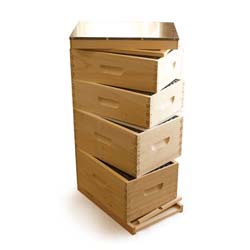Cleaning tools (honey extractor, uncapping tank, uncapping tools, etc.) after honey harvest is a crucial step. No matter your method, it’s important to clean all honey harvesting tools after each use to keep them in top shape and ready for the next season (and so you will have less work to do later on). The last thing you want as a beekeeper is to have another thing on your to-do list during summertime.
Cleaning up after harvesting honey is essentially the same no matter how many frames you extract. But of course, the more frames of honey you extract, the more frames you’ll need to clean up and store over winter. When dealing with wet honey frames, try to be far away from your apiary and with closed windows and doors.
Potential things to do with your wet, freshly extracted frames:
- Shake them out as much as possible. You could leave a honey bucket with a filter on it and try to shake as much of the honey out to get as much as possible.
- Place the empty frames back into a super and put it back on your hives for a few days. This allows the bees to clean them out and leave you with fresh clean frames.
- Make sure that frames are completely dry before storing which can be done in bins with lids in your basement or a storage room.
- Remove the cleaned frames and store them away. Freezing them will keep any pests/wax moths away from the frames. If you freeze them when they’re still wet with honey, it could make the frames more enticing for next honey harvest (luring the bees up into the honey super faster than they normally might). If you don’t have the freezer space to keep your frames in all winter long, an initial freeze for 24-48 hours to kill any pests will suffice and the frames can be stored in a well-ventilated, cool, dry space – be mindful of pests such as mice looking for a cozy place to live during winter. You also want to protect your frames from small hive beetles and wax moths.
